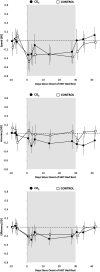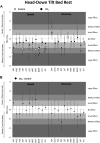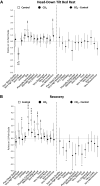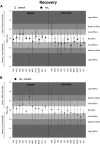Effects of head-down tilt bed rest plus elevated CO2 on cognitive performance
- PMID: 33630672
- PMCID: PMC8262780
- DOI: 10.1152/japplphysiol.00865.2020
Effects of head-down tilt bed rest plus elevated CO2 on cognitive performance
Abstract
Microgravity and elevated CO2 levels are two important environmental spaceflight stressors that can adversely affect astronaut cognitive performance and jeopardize mission success. This study investigated the effects of 6° head-down tilt bed rest (HDBR) with (n = 11 participants, 30-day HDBR) and without (n = 8 participants, 60-day HDBR) elevated ambient (3.73 mmHg) CO2 concentrations on cognitive performance. Participants of both groups performed all 10 tests of NASA's Cognition battery and a brief alertness and mood survey repeatedly before, during, and after the HDBR period. Test scores were adjusted for practice and stimulus set effects. Concentrating on the first 30 days of HDBR, a modest but statistically significant slowing across a range of cognitive domains was found in both groups (controls: -0.37 SD; 95% CI -0.48, -0.27; adjusted P < 0.0001; CO2: -0.25 SD; 95% CI -0.34, -0.16; adjusted P < 0.001), most prominently for sensorimotor speed. These changes were observed early during HDBR and did not further deteriorate or improve with increasing time in HDBR. The study found similar cognitive effects of HDBR irrespective of CO2 levels, suggesting that elevated CO2 neither ameliorated nor worsened the HDBR effects. In both groups, cognitive performance after 15 days of recovery was statistically indistinguishable from pre-HDBR performance. However, subjects undergoing 60 days of HDBR rated themselves as feeling more sleepy, tired, physically exhausted, stressed, and unhealthy during recovery compared to their 30-day counterparts.NEW AND NOTEWORTHY This study investigated the effects of prolonged head-down tilt bed rest with and without elevated (3.73 mmHg) levels of ambient CO2 on cognitive performance across a range of cognitive domains and is one of the few studies investigating combined effects of environmental stressors prevalent in spaceflight. The study showed moderate declines in cognitive speed induced by head-down tilt bed rest and suggests that exposure to elevated levels of ambient CO2 did not modify this effect.
Keywords: CO2; cognition; microgravity; performance; spaceflight.
Conflict of interest statement
No conflicts of interest, financial or otherwise, are declared by the authors.
Figures




Similar articles
-
Continuous and Intermittent Artificial Gravity as a Countermeasure to the Cognitive Effects of 60 Days of Head-Down Tilt Bed Rest.Front Physiol. 2021 Mar 17;12:643854. doi: 10.3389/fphys.2021.643854. eCollection 2021. Front Physiol. 2021. PMID: 33815148 Free PMC article.
-
Brain connectivity and behavioral changes in a spaceflight analog environment with elevated CO2.Neuroimage. 2021 Jan 15;225:117450. doi: 10.1016/j.neuroimage.2020.117450. Epub 2020 Oct 16. Neuroimage. 2021. PMID: 33075558
-
Head Down Tilt Bed Rest Plus Elevated CO2 as a Spaceflight Analog: Effects on Cognitive and Sensorimotor Performance.Front Hum Neurosci. 2019 Oct 17;13:355. doi: 10.3389/fnhum.2019.00355. eCollection 2019. Front Hum Neurosci. 2019. PMID: 31680909 Free PMC article.
-
The effects of a spaceflight analog with elevated CO2 on sensorimotor adaptation.J Neurophysiol. 2021 Feb 1;125(2):426-436. doi: 10.1152/jn.00306.2020. Epub 2020 Dec 9. J Neurophysiol. 2021. PMID: 33296611
-
Are head-down tilt bedrest studies capturing the true nature of spaceflight-induced cognitive changes? A review.Front Physiol. 2022 Dec 13;13:1008508. doi: 10.3389/fphys.2022.1008508. eCollection 2022. Front Physiol. 2022. PMID: 36582360 Free PMC article. Review.
Cited by
-
Cognition in zero gravity: Effects of non-terrestrial gravity on human behaviour.Q J Exp Psychol (Hove). 2023 May;76(5):979-994. doi: 10.1177/17470218221113935. Epub 2022 Aug 6. Q J Exp Psychol (Hove). 2023. PMID: 35786100 Free PMC article.
-
Brains in space: the importance of understanding the impact of long-duration spaceflight on spatial cognition and its neural circuitry.Cogn Process. 2021 Sep;22(Suppl 1):105-114. doi: 10.1007/s10339-021-01050-5. Epub 2021 Aug 18. Cogn Process. 2021. PMID: 34409546 Free PMC article.
-
Cognitive performance in ISS astronauts on 6-month low earth orbit missions.Front Physiol. 2024 Nov 20;15:1451269. doi: 10.3389/fphys.2024.1451269. eCollection 2024. Front Physiol. 2024. PMID: 39633651 Free PMC article.
-
Effects of 12 weeks of Head-Down Strong Abdominal Breathing Training on Gait and Cognitive Function in Patients with Chronic Obstructive Pulmonary Disease.Int J Chron Obstruct Pulmon Dis. 2025 May 1;20:1347-1359. doi: 10.2147/COPD.S514766. eCollection 2025. Int J Chron Obstruct Pulmon Dis. 2025. PMID: 40330797 Free PMC article. Clinical Trial.
-
Dynamic ensemble prediction of cognitive performance in spaceflight.Sci Rep. 2022 Jun 30;12(1):11032. doi: 10.1038/s41598-022-14456-8. Sci Rep. 2022. PMID: 35773291 Free PMC article.
References
-
- Marshall-Goebel K, Laurie SS, Alferova IV, Arbeille P, Aunon-Chancellor SM, Ebert DJ, Lee SMC, Macias BR, Martin DS, Pattarini JM, Ploutz-Snyder R, Ribeiro LC, Tarver WJ, Dulchavsky SA, Hargens AR, Stenger MB. Assessment of jugular venous blood flow stasis and thrombosis during spaceflight. JAMA Netw Open 2: e1915011, 2019. doi:10.1001/jamanetworkopen.2019.15011. - DOI - PMC - PubMed
Publication types
MeSH terms
Substances
Grants and funding
LinkOut - more resources
Full Text Sources
Other Literature Sources

